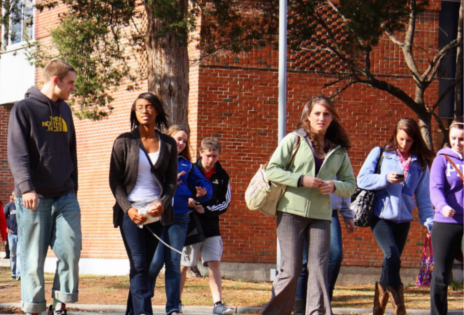Erin Peters Burton's Research Takes Her to STEM School in NC
The NSF-funded research of Erin Peters Burton, assistant professor of science education at CEHD, recently took her to Goldsboro, NC as part of a study of successful STEM high schools.

Wayne School of Engineering in Goldsboro, NC. Photo: Goldsboro Daily News.
* * *
(This article was written by Robyn Wade and excerpted from Goldsboro Daily News.)
Goldsboro, N.C. — This past week, a research team funded by the National Science Foundation visited the Wayne School of Engineering (WSE) in order to determine what strategies and support systems are in place which have attributed to the school's success as a STEM school. The school was one of 12 STEM schools nationwide selected for the study.
The project title for the research study was Opportunities Structures for Preparation and Inspiration (OSPrI). The research team consisted of members from George Washington University, George Mason University, and the Stanford Research Institute. The OSPrI team states that the WSE was the second school to be selected for the research study, in large part because all WCPS students, regardless of academic standing or socioeconomic status, have the opportunity to attend the school and are enrolled through an unbiased lottery selection process.
"Wayne School of Engineering really stood out among other schools across the country," states Dr. Erin Peters Burton, OSPrI Co-Principal Investigator [and assistant professor of science education at George Mason University's College of Education and Human Development]. "Some STEM schools only accept the very best and the brightest. We wanted to better understand how a school like this one can be so successful within its current design, and then highlight those areas of strength as a model for other schools."
This past school year, the Wayne School of Engineering had a 91.5% Performance Composite, met 100% of its Annual Measurable Objectives and had a 98% graduation rate.
The OSPrI research team states that the four year $2.8 million National Science Foundation study will examine 10 critical components at the school:
- Curriculum structure
- Reform practices being used (e.g. classroom based learning)
- Technology usage/integration
- Formal/Informal blended learning
- Well prepared STEM staff (e.g. professional development)
- Special supports (e.g. tutoring systems)
- Administrative structure/support
- Community contacts that demonstrate real world applications to instruction
- Community partnerships
- Early college preparation
"The feel of the school, it is like a home or a family, and we felt so welcome," adds Dr. Burton. "The teachers are so collaborative. It is not just science teachers planning with other science teachers, but there are teachers of all different areas collaborating together and strengthening the curriculum."
Quick facts about WSE:
- Opened in 2007.
- Offers an innovative curriculum that is integrated with science, technology, engineering, and math.
- Students complete rigorous courses steeped in STEM education, while also having the opportunity to complete college courses or seek a two year degree.
- In 2009, selected by the North Carolina New Schools Project to be a national "Learning Lab."
- In 2012, expanded to include middle grades.
- In 2013, to begin offering STEM Learning Center courses to middle grade students and Digital Media Courses to high school students.
- Partnered with Wayne Community College and East Carolina University.
- Initially started after receiving a planning grant from the Bill & Melinda Gates Foundation.
About CEHD
George Mason University's College of Education and Human Development (CEHD) includes two schools, the Graduate School of Education, which is the largest in Virginia, and the School of Recreation, Health, and Tourism. CEHD offers a comprehensive range of degrees, courses, licensures, and professional development programs on campus, online, and on site. The college is distinguished by faculty who encourage new ways of thinking and pioneering research supported by more than $75 million in funding over the past five years.
For additional information:
- Contact CEHD Communications: cehdnews@gmu.edu
- College of Education and Human Development: cehd.gmu.edu
- Graduate School of Education: gse.gmu.edu
Follow CEHD on Facebook at www.facebook.com/MasonCEHD or Twitter at @MasonCEHD.
